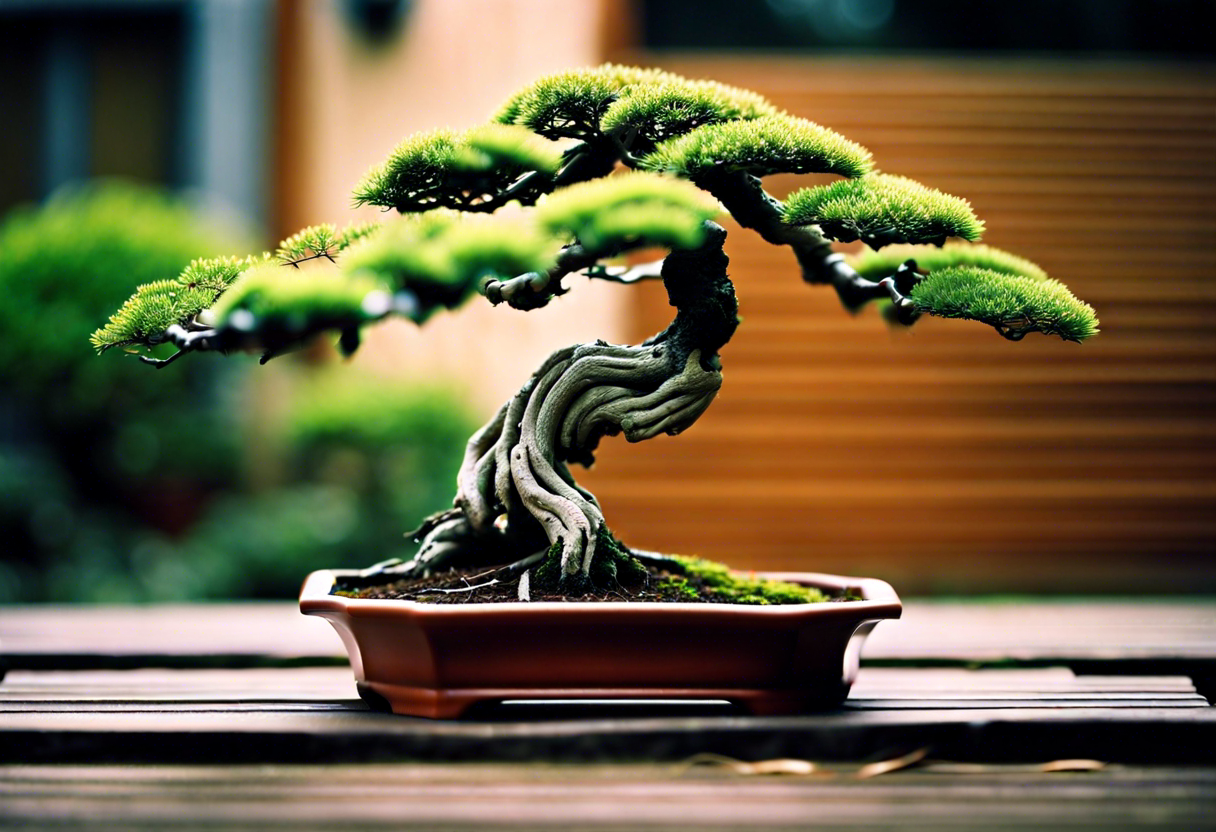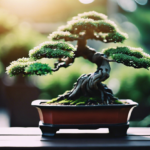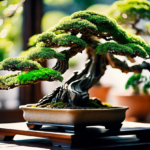Bonsai Tree Pruning Techniques Explained
When it comes to bonsai tree pruning techniques, there are several methods that bonsai enthusiasts can utilize to keep their miniature trees healthy and aesthetically pleasing. One common method is known as "maintenance pruning," which involves regularly trimming back new growth to maintain the tree’s desired shape and size. This technique is essential for promoting ramification, which is the branching out of smaller secondary branches from larger primary branches, creating a full and lush canopy.
Another important pruning technique is "structural pruning," which focuses on enhancing the tree’s overall structure by selectively removing larger branches to improve the bonsai’s silhouette and balance. This method is typically done during the tree’s dormancy period to minimize stress on the plant. By strategically pruning branches that disrupt the tree’s desired design, bonsai enthusiasts can guide the tree’s growth and create a more harmonious aesthetic.
One more advanced technique is "defoliation," which involves removing most or all of the leaves from the tree to encourage new growth and reduce leaf size. This technique is beneficial for refining the bonsai’s silhouette and ramification, as it redirects the tree’s energy towards producing new foliage. However, defoliation should be done with caution and only on species that can tolerate such drastic measures.
Moreover, "pinching" is a delicate pruning technique used to control the tree’s growth and shape. By gently pinching off new shoots with fingers or shears, bonsai enthusiasts can promote back-budding and encourage the development of finer ramification. This technique is particularly useful for creating dense foliage pads and defining the tree’s overall silhouette.
Mastering various bonsai tree pruning techniques is essential for maintaining the health and beauty of these miniature trees. By understanding the different methods available and applying them appropriately, bonsai enthusiasts can cultivate stunning specimens that showcase the artistry and dedication that go into the ancient practice of bonsai cultivation.
For more in-depth information on bonsai tree pruning techniques, visit Bonsai Empire.
Tips for Shaping Bonsai Trees Through Pruning
When it comes to shaping your Bonsai tree through pruning, there are several key tips to keep in mind to ensure that your tree stays healthy and maintains its aesthetic appeal. Pruning is a fundamental aspect of Bonsai tree care, as it helps control the growth patterns and encourages the tree to develop a specific shape.
One essential tip is to have a clear idea of the desired shape you want for your Bonsai tree before starting the pruning process. Whether you aim for a formal upright style, informal upright style, or cascading style, knowing the end goal will guide your pruning decisions. Visualizing the tree’s future appearance will help you make precise cuts to achieve the desired shape gradually.
Another crucial tip is to use the right tools for pruning your Bonsai tree. Sharp and high-quality shears or scissors specifically designed for Bonsai tree pruning are necessary to make clean cuts without causing damage to the tree. Regularly disinfecting your tools with alcohol before and after pruning sessions helps prevent the spread of diseases between cuts.
Timing is key when it comes to pruning Bonsai trees. While pruning can generally be done throughout the year, spring is often considered the best time for major pruning sessions when the tree is actively growing. However, light pruning and maintenance work can be carried out year-round to keep the tree in shape.
Understanding the different types of pruning cuts is essential for shaping Bonsai trees effectively. Pinching, scissor cutting, and branch trimming are common techniques used to refine the tree’s silhouette and encourage new growth in specific areas. Each cut serves a different purpose and should be applied thoughtfully to achieve the desired outcome.
Regular monitoring and maintenance after pruning are crucial to ensure the tree’s health and vitality. Keeping an eye on the tree for any signs of stress, such as wilting leaves or slow growth, allows for prompt adjustments to the care routine. Providing proper light, water, and nutrients following a pruning session supports the tree’s recovery and growth.
These tips into your Bonsai tree care routine will help you shape your tree effectively through pruning while promoting its overall health and resilience. For more in-depth guidance on Bonsai tree pruning techniques and shaping practices, visit Bonsai Empire.
Understanding when to prune your Bonsai tree
When it comes to cultivating a healthy and visually appealing Bonsai tree, understanding the appropriate timing for pruning is crucial. Pruning plays a significant role in maintaining the shape, size, and overall well-being of your Bonsai tree. Here are some essential factors to consider when determining when to prune your Bonsai tree.
Season: The timing of pruning your Bonsai tree largely depends on the season. In general, the best time to prune deciduous trees is during late winter or early spring before new growth appears. Coniferous trees, on the other hand, can be pruned in late spring or early summer.
Growth Stage: Another critical aspect to consider is the growth stage of your Bonsai tree. For young trees, frequent pruning is necessary to shape the tree and encourage healthy growth. Once the desired structure is achieved, routine maintenance pruning should be performed to refine the tree’s appearance.
Flowering Time: If your Bonsai tree is a flowering species, it is essential to research the specific flowering times. Pruning at the wrong time could potentially remove flower buds and diminish the aesthetic appeal of the tree. Always prune after the flowering period to ensure minimal impact on future blooms.
Health Assessment: Regularly inspecting the health of your Bonsai tree is crucial before pruning. Remove any dead, diseased, or damaged branches promptly to prevent the spread of infections. Additionally, pruning during the dormant season can help rejuvenate the tree and promote healthy growth in the following season.
By understanding these key factors and observing your Bonsai tree closely, you can determine the optimal time for pruning to enhance its beauty and ensure its vitality. For more in-depth insights into Bonsai tree care and maintenance, you can refer to reputable sources like Bonsai Empire or Bonsai Outlet.
Remember, patience and careful consideration are essential when deciding when to prune your Bonsai tree. Following the appropriate timing guidelines will not only benefit the tree’s growth and appearance but also deepen your connection with this ancient art form.
Common Mistakes to Avoid During Bonsai Tree Pruning
Pruning is an essential aspect of bonsai tree care, but it can be easy to make mistakes that harm your tree rather than help it thrive. By being aware of these common errors, you can ensure that your bonsai tree pruning sessions are beneficial and promote the health and beauty of your miniature tree.
One of the most common mistakes beginners make when pruning a bonsai tree is cutting branches too close to the trunk. This can cause damage to the tree and lead to decay or infection. It’s vital to leave a small collar of tissue when pruning branches to help the tree heal properly. Additionally, pruning at the wrong time of year can stress the tree. Understanding the specific growth patterns of your bonsai tree species will help you determine the best time to prune for optimal results.
Another mistake to avoid is over-pruning. While it’s essential to maintain the shape and size of your bonsai tree, excessive pruning can weaken the tree and inhibit its growth. Always have a clear plan in mind before pruning and avoid unnecessary cutting. Remember, less is often more when it comes to bonsai tree pruning.
Using improper tools is also a common mistake that can harm your bonsai tree. Dull or dirty tools can cause ragged cuts that take longer to heal, leaving your tree vulnerable to disease. Ensure your pruning shears are sharp and clean before starting any pruning session. Additionally, using the wrong type of tool for the job can lead to damage. Invest in high-quality bonsai pruning tools and learn how to use them correctly for the best results.
Not considering the tree’s overall design and aesthetic during pruning is another mistake to avoid. Each cut you make should contribute to the tree’s overall shape and style. Take your time to assess your bonsai tree from all angles before starting to prune, and envision how each cut will impact the tree’s appearance.
By being mindful of these common mistakes and following proper bonsai tree pruning techniques, you can help your tree thrive and flourish for years to come. Remember to research your specific bonsai tree species for tailored care guidelines and seek advice from experienced bonsai enthusiasts to refine your pruning skills further.
For more in-depth guidance on bonsai tree pruning techniques, visit Bonsai Empire.
Exploring Advanced Pruning Techniques for Bonsai Trees
Pruning is a fundamental aspect of bonsai tree care, and mastering advanced techniques can take your bonsai to the next level. While basic pruning focuses on maintenance and shaping, advanced techniques delve into more intricate methods to refine the tree’s structure and enhance its overall aesthetic appeal.
One advanced pruning technique is defoliation, which involves selectively removing the leaves of the bonsai tree. This process not only reduces leaf size but also encourages ramification, the development of finer branches. Defoliation is typically performed on deciduous trees during the growing season to promote multiple flushes of growth, resulting in denser foliage pads and finer branching.
Another advanced technique is jin and shari, which involves creating deadwood features on the bonsai tree. Jin are bare, dead branches stripped of bark, while shari is the intentional stripping of bark along the trunk to mimic the effect of weathering or natural damage. These techniques add character and age to the bonsai, imbuing it with a sense of maturity and authenticity.
Thread-grafting is a more advanced approach to shaping the bonsai tree’s trunk and branches. This technique involves carefully wrapping a young branch with wire to encourage it to grow in a specific direction, ultimately creating movement and visual interest in the tree’s design. Thread-grafting requires precision and patience but can result in striking, dynamic compositions.
Bonsai enthusiasts looking to refine the silhouette of their trees often turn to layering, an advanced technique that promotes the development of new roots along a tree’s trunk. By air-layering a section of the tree, growers can create nebari, or surface roots, closer to the base of the trunk. This technique enhances the tree’s stability and visual impact, creating a strong foundation for the bonsai’s overall design.
Exploring advanced pruning techniques for bonsai trees opens up a world of creative possibilities for growers seeking to elevate their artistry and craftsmanship. By experimenting with defoliation, jin and shari, thread-grafting, and layering, bonsai enthusiasts can transform their trees into captivating living sculptures that reflect nature’s beauty and complexity.
For more information on advanced bonsai pruning techniques, visit Bonsai Empire.
Conclusion
Mastering the art of Bonsai tree pruning techniques opens up a world of creativity and skillful cultivation for enthusiasts. By exploring the various methods of pruning, individuals can shape their Bonsai trees with precision and care. From the traditional approach of maintenance pruning to the advanced techniques that allow for intricate designs, there is a method suited for every level of expertise. Understanding the significance of when to prune your Bonsai tree is crucial for its health and aesthetic appeal. By following the seasonal guidelines and monitoring the tree’s growth patterns, one can ensure successful pruning sessions that promote growth and vitality.
In addition to the techniques themselves, there are essential tips for shaping Bonsai trees through pruning that can elevate the overall look of the tree. From focusing on branch structure to creating taper and movement, these tips help create a harmonious and visually pleasing Bonsai composition. Avoiding common mistakes during Bonsai tree pruning is equally important to prevent damage or stress to the tree. By being mindful of over-pruning, incorrect branch angles, and neglecting aftercare, enthusiasts can maintain the health and beauty of their Bonsai trees.
For those looking to take their pruning skills to the next level, exploring advanced techniques can lead to exceptional and unique Bonsai creations. Techniques such as approach grafting, thread grafting, and defoliation allow for intricate design possibilities and the development of distinctive tree shapes. However, it is crucial to approach these advanced techniques with caution and practice, as they require a deeper understanding of Bonsai physiology and growth patterns.
Mastering Bonsai tree pruning techniques involves a combination of knowledge, skill, and patience. By familiarizing oneself with the various pruning methods, understanding when to prune, and implementing essential tips for shaping, enthusiasts can create stunning Bonsai compositions. Avoiding common mistakes and gradually exploring advanced pruning techniques can further enhance one’s abilities and lead to the development of truly exceptional Bonsai trees. With dedication and practice, individuals can cultivate Bonsai trees that reflect both their creativity and appreciation for this ancient art form.


